I can’t say when I first learned of the Danube River. Perhaps a zealous geography teacher impressed the name in my adolescent mind. More likely, I read about it in one of the National Geographic magazines that were always stacked haphazardly in the front hall of my childhood home. Back then, the name evoked romance, history, and an endless parade of Romans, Ottomans and Austro-Hungarians following its braided and looped course across central Europe. Fifty years later, the mystique surrounding the word still held me in such sway that upon arriving in Bratislava, Slovakia I stepped off the bus and turned my back on the Old Town. First and foremost, the river beckoned.
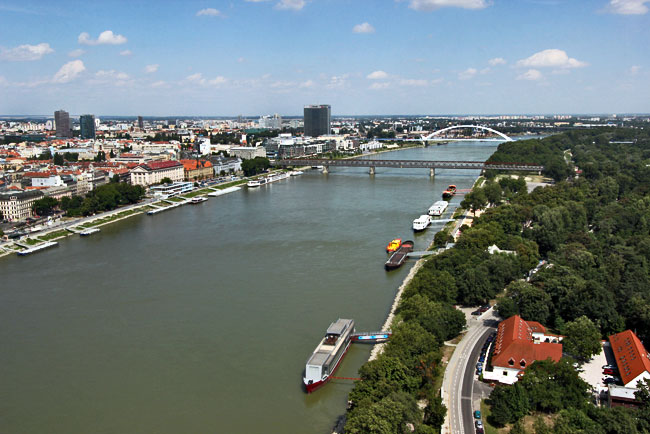
Tamed within concrete embankments, the lazy gray-green Danube caught up in whorls beneath SNP Bridge, as if perturbed by the bizarre metal tower that anchors one end of the city’s main river crossing. Like the river, I was initially disturbed by the saucer-shaped disc, appropriately named the UFO Restaurant and observation deck, that balanced precariously on top of the tower’s concave metal legs. It seemed entirely out of place, something of an eyesore, until I realized that the river would take even aliens in stride, just as it had withstood the onslaught of countless conquering armies over the centuries.
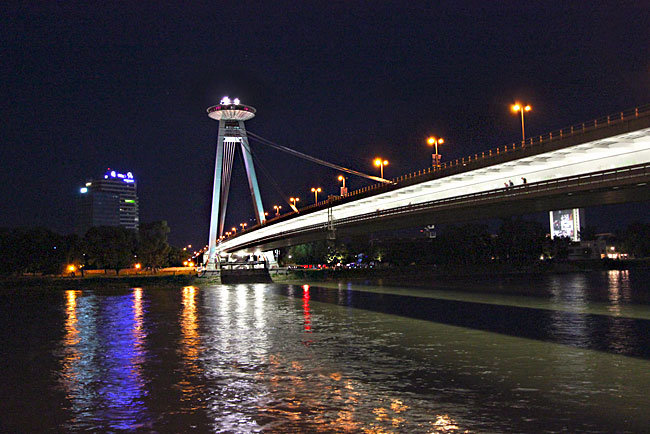
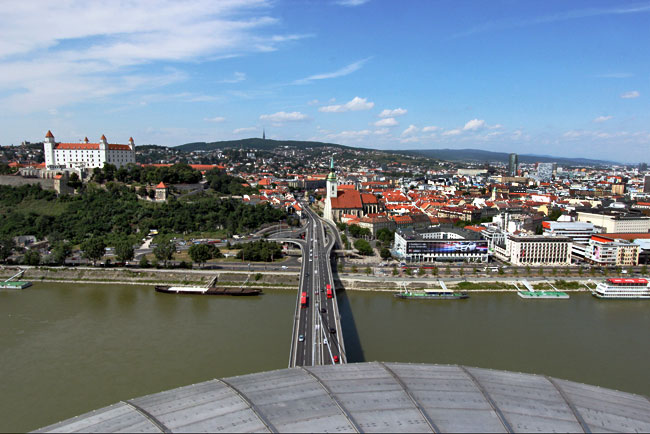
Having drunk in my fill of the Danube, I turned and slogged uphill toward the massive rectangular stone castle that is often described as an upside-down table because of the square towers that jut from its four corners. Strategically located near the geographic center of Europe, at a natural passage between the Carpathian Mountains and the Alps, Bratislava has been fought over for thousands of years. Fortifications became necessary when important trade routes between the Balkans and the Baltic Sea crossed at the town then known by the old German name of Pressburg. The initial 10th century fortress, which was probably constructed from material reclaimed from Roman structures, was built and rebuilt until it began to attain its current rectangular footprint in the 15th century. Hungarian monarchs took refuge here when Turks invaded and conquered Buda (now Budapest) in the 16th and 17th centuries, making it the seat of the Kingdom of Hungary. When the Hapsburgs migrated back to Vienna and Budapest in 1783, the castle fell into disrepair and was reconfigured for use as a military barracks, until an unfortunate fire in 1811 left a charred shell that was subsequently abandoned.
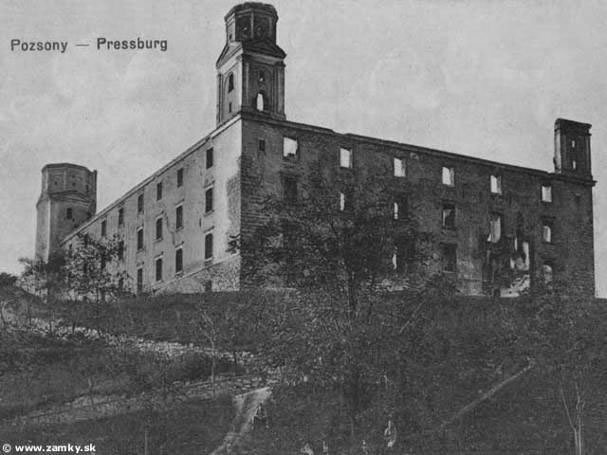
Numerous attempts to demolish the ruins after World War II to make way for new government facilities were thwarted and finally in 1953, the decision was made to restore the castle. At the top of the hill I faced the monolithic fortress and tried to envision its many iterations. By the 12th century the castle had evolved into a neo-Romanesque stone palace and in the mid-15th century it was reconfigured as a Gothic palace by King Sigismund, who made it the center of his new German-Czech-Hungarian empire. Not to be outdone, the Hapsburgs rebuilt it in the Italianate Renaissance style a century later and over the ensuing couple of centuries it was modified in the Baroque style with Rococo touches.
By the time Maria Theresa of Austria became queen of the Kingdom of Hungary in 1740 and moved into the castle, it looked much as it does today, and it is this latter Baroque configuration to which restorers have been faithful. Substantial work really only began in 2005 and restoration had been largely completed just a few months prior to my arrival. I stepped back to the edge of the balcony and let my gaze sweep upward to angry gray clouds that cloaked the castle’s stark white towers. Where the Danube had meandered by with quiet strength, the castle massif exuded raw power. It was marvelous. And it was utterly sterile.

Unsettled, I turned to gaze out over the river and the Slovakian plains beyond, where further signs of schizophrenia began to emerge. Directly across the river, in the suburbs of Bratislava, row after row of sterile Soviet-era housing complexes stretched to the horizon. To the east the plain was riddled with red and white striped smokestacks, industrial plants on Slovakian soil but owned by Hungary. To the west, in Austria, lay a sea of wind turbines.
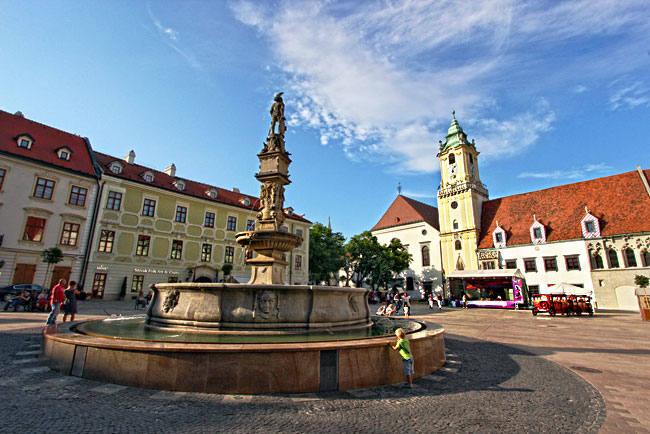
I spent a couple more hours walking around the historic center of town, with its meticulously restored palaces, churches, and wedding cake opera houses. Old Town is exquisite and yet, I couldn’t shake the feeling that this was a town full of people who had no true sense of identity. Even in the Tourist office, I felt no sense of national pride, no eagerness to show off their city. Perhaps this has to do with the fact that Bratislava has suffered repeated onslaughts throughout history. Its latter day politics, culture, and religion have been influenced by Germans, Austrians, Czechs, Jews, Hungarians, and Slovaks, not to mention 41 years of oppressive Communist rule. The city and its residents have absorbed it all and emerged, slightly scathed and a bit dazed, though certainly to be admired for their perseverance.
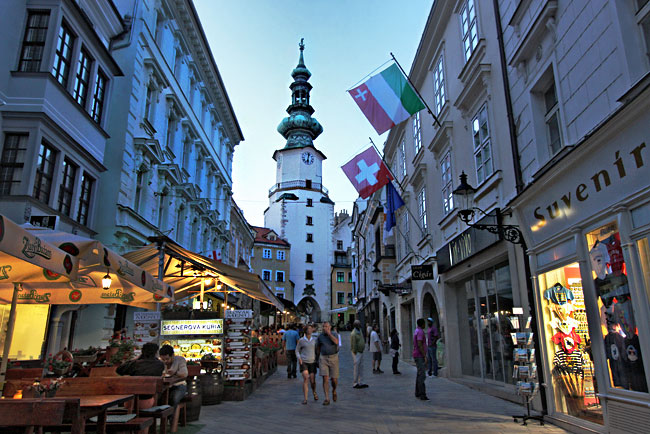
Bratislava is worth a visit but unless you come during one of their festivals, a day is all that’s necessary. After the Danube, UFO Tower, Old Town, and the Castle, there’s little more to see and do.

Hi.We have to drive from London to northern Romania soon and I’m trying to pick a route. Would you recommend going through Austria rather than Slovakia? I have to go to Prague so it would mean cutting south. Whichever, it will be an adventure!
Oh boy, Alyson, I can’t really be much help to you with this issue, as I always just rely on public transportation for my travels.
Hi Barbara… I am excited to have just found your blog. My husband and I are about to set off on something similar as I escape my corporate life.
I love to see posts on Bratislava. While a day is fine for many, we lived there 18 months and loved every second of it!
Should you return, rent a bike and head to the Austrian countryside….some of my fondest memories.
Travel well…. Julie
Hi Julie: And I’m so glad you found my blog! I wish you the very best as you set off on your journey, but be prepared, for travel of the kind we do is life-changing.
As a native of Slovakia who lived in Bratislava from 1995 to 2000, I’m so glad you enjoyed Slovakia’s capital. As Amanda says, there’s plenty more to see and do beyond the places you mention, but that’s perhaps for another visit. Hopefully you’ll venture past Bratislava then, too, it’s very nice out there, especially the Tatra Mountains. My wife and I visited my home country this summer and documented it on our round-the-world travel blog, check it out if you have a moment.
Glad to have discovered your blog!
Hi Peter: I have heard that the eastern mountains of Slovakia are exquisite, and really hope to visit that area one day. I see you’ve been traveling in Greece, and I’ll read those articles as I’m headed there next summer. But I was shocked by your $100 per day budget – I do it on no more than $30 per day, averaging it throughout the year, by combining pricier places like Europe with budget places like SE Asia. Thanks for reading my blog, and for your kind comment.
Have fun in Greece! We loved it, miss it dearly here in Istanbul, Turkey.
The $100/day budget is a daily average maximum for the two of us. We’re glad to have discovered it’s a generous figure – we’re way below that even after traveling through Europe for five months. In any case, it’s so that we don’t have to turn every coin twice, as the Slovak saying goes. We stay in apartments, treat ourselves to a nice dinner or hotel every once in a while, feel free to visit expensive museums like the Topkapi Palace… We’re off to SE Asia next.
Hi Peter: I’m in Chiang Mai, Thailand until Dec.15th and then 3 days in Bangkok – if you plan to be in either of these places during that time let me know and maybe we can get together.
I´ve had the opportunity to visit Bratislava some time ago and the thing you wrote about their virtually non-existent national pride is absolutely true…except for hockey maybe, there you can see some real fire! Anyway, independent Slovakia was established only some twenty years ago if I remember correctly, so maybe all they need is time..to get to the point where they realize their own value and history. Slovakia is a lovely piece of land, and High Tatras in particular, but I´m wondering if part of that beauty does not lay in the fact that it´s still a bit forgotten by the world, or better to say not yet discovered..
Hi Adam: I’ve heard some good things about eastern Slovakia, up in the mountains. They say it’s beautiful. I may have to check that out.
Barbara, I love the story of your history of Bratislava.I think you are great travel writer right now.
Eitan – that is a perfectly lovely thing to say. Thank you so much.
Barbara, I love your tale of the history of Bratislava … but if you get the chance give it another go! I lived there for a year and I think it’s the kind of place you need to see through the eyes of a local. Lots of hidden nooks and crannies that are just wonderful. I loved it!
I did love the city, Amanda.It is so well kept and lovingly restored. But I had horrible experiences with the people, especially the bus drivers, who were rude beyond belief. Unfortunately, for me travel is all about the people I meet, and this time I never really connected with anyone.